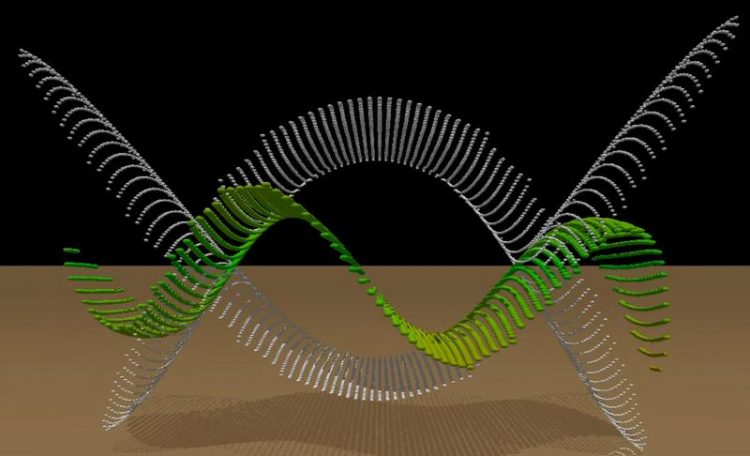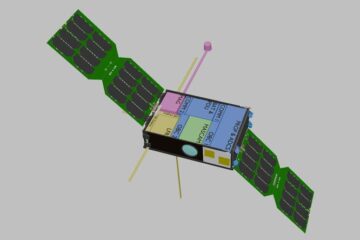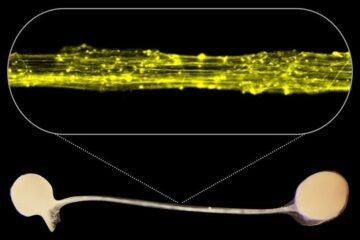Video of a phenomenon: Standing waves that won’t stand still

Excerpt from a video showing the standing wave with travelling properties. White: Nodes and antinodes of the standing wave which are repeatedly passed through. Green: Snapshot of the wave. UDE / B. Zingsem (AG Farle)
A wave consists of antinodes and nodes. If you imagine this on a rope, the antinodes are the areas which swing up and down, whereas nodes are the points in between. With a standing wave, nodes and antinodes always remain at the same position and do not move along the rope.
In travelling waves on the other hand, nodes and antinodes do not remain in place: If you start shaking a rope from one end, you will excite a wave that travels down the rope until it reaches the other end.
Benjamin Zingsem from the research group of UDE's Professor Michael Farle has now observed the apparent paradox for the first time: For this purpose, he worked with, what physicists call a chiral magnet:
A magnetic material in which the so called Dzyaloshinskii-Moriya interaction occurs. In such magnets, all dipoles – the tiny magnets that make up the solid – are slightly tilted towards each other with a certain direction, like screw windings.
If the system is resonantly excited, a standing wave with travelling properties is formed. This wave has stationary nodes and antinodes, but at the same time a continuous phase shift creates the impression of a travelling wave. “I had to look at it for a long time before I could put it into words. I only really understood it by watching a video of the phenomenon,” says Zingsem.
The effect reveals previously unknown transport properties in such systems. Which may, for example, be harnessed in future technology, as, information can be stored, transmitted and processed via magnetic oscillations without generating heat, which is the main bottleneck in conventional electronics.
In general, standing waves are fundamental for understanding all types of matter and they are the foundation for our understanding of chemistry.
In this project Zingsem collaborated with colleagues from the University of Colorado (USA) and the University of Glasgow (UK).
Editor: Birte Vierjahn, +49 203 37-9 8176, birte.vierjahn@uni-due.de
Benjamin Zingsem, Faculty of Physics and Forschungszentrum Jülich, +49 203 37-9 4411, benjamin.zingsem@uni-due.de
B.W. Zingsem, M. Farle, R.L. Stamps, and R.E. Camley, Unusual nature of confined modes in a chiral system: Directional transport in standing waves Phys. Rev. B,99:214429, Jun 2019. https://doi.org/10.1103/PhysRevB.99.214429
Video of the phenomenon: http://udue.de/standingWaveComparison
Media Contact
All latest news from the category: Physics and Astronomy
This area deals with the fundamental laws and building blocks of nature and how they interact, the properties and the behavior of matter, and research into space and time and their structures.
innovations-report provides in-depth reports and articles on subjects such as astrophysics, laser technologies, nuclear, quantum, particle and solid-state physics, nanotechnologies, planetary research and findings (Mars, Venus) and developments related to the Hubble Telescope.
Newest articles

Caution, hot surface!
An international research team from the University of Jena and the Helmholtz Institute Jena are demystifying the mechanisms by which high-intensity laser pulses produce plasma on the surface of solids….

Exploring the Asteroid Apophis With Small Satellites
In five years’ time, a large asteroid will fly very close to Earth – a unique opportunity to study it. Concepts for a national German small satellite mission are being…

First model of the brain’s information highways developed
Our human brain is not only bigger and contains more neurons than the brains of other species, but it is also connected in a special pattern: Thick bundles of neurons…





















